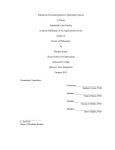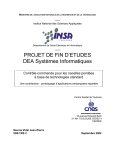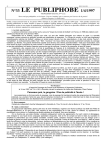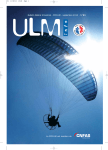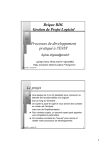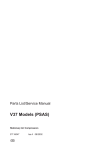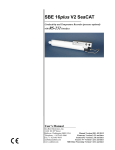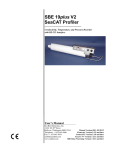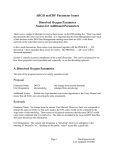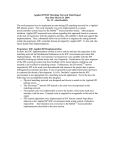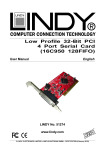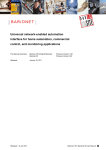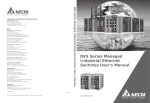Download NEPTUNE CANADA - Tempo-mini V2 Documentation_d
Transcript
Centre de Brest Département Recherche et Développements Technologiques Programme 8, projet 8 Observatoires fond de mer pluridisciplinaires NEPTUNE CANADA : TEMPO-MINI V2 documentation établi le : par : Réf : n° analytique : Indice : 31/01/11 J. Legrand RDT/EIM/10-053 A080806 d Diffusion : IFREMER Auffret Yves (RDT/EIM) Bescond Tanguy (RDT/EIM) Blandin Jérôme (RDT/IPR) Caradec Florian (RDT/EIM) Coail Jean-Yves (RDT/EIM) Delauney Laurent (RDT/EIM) Laës Agathe (RDT/EIM) Le Gall Christian (EEP/LEP) Sarradin Pierre-Marie (EEP/D) Sarrazin Josée (EEP/LEP) Diffusion : confidentielle NEPTUNE CANADA Pirenne Benoît (Neptune Canada) Hasanen Reece (Neptune Canada) Pautet Lucie (Neptune Canada) Lavallee Tim (Neptune Canada) Wallace Kim (Devocean) Williams Jason (Highland-Tech) restreinte ❏ libre ❏ NEPTUNE Canada : TEMPO-MINI V2 Documentation DOCUMENT VERSIONS Version Date Description Reference secretariat A 19/02/10 Document creation RDT/EIM/10-015 B Modification §10.1 :add of a CHLORINATION 03/12/10 initialisation phase §10.3 : inversion of the chlorination command RDT/EIM/10-053 C 12/01/11 Connectors added on the synoptic drawing (§2) - D 31/01/11 Chemini data description completed (§9.5) - SUMMARY 1 - Introduction...................................................................................................................................4 2 – Synoptic drawing..........................................................................................................................5 3 – The electronic unit........................................................................................................................6 3.1 Ethernet switch....................................................................................................................................7 3.2 Barionet n°1 .........................................................................................................................................7 3.3 Barionet n°2 .......................................................................................................................................10 4 – Oil filled junction box ................................................................................................................12 5 - Camera.........................................................................................................................................13 5.1 – Information.....................................................................................................................................13 5.2 - Technical specifications ..................................................................................................................13 6 – Lights ...........................................................................................................................................15 6.1 – Information.....................................................................................................................................15 6.2 – Example...........................................................................................................................................15 7 – Oxygen Sensor ............................................................................................................................16 7.1 – Information.....................................................................................................................................16 7.2 – Data frame ......................................................................................................................................16 7.3 – Example...........................................................................................................................................17 8 – T° probe.......................................................................................................................................18 RDT/EIM/10-053 2/25 31/01/2011 NEPTUNE Canada : TEMPO-MINI V2 Documentation 8.1 – Information.....................................................................................................................................18 8.2 – Example...........................................................................................................................................18 9 – CHEMINI Chemical analyser...................................................................................................19 9.1 – Information.....................................................................................................................................19 9.2 - CHEMINI main specifications.......................................................................................................19 9.3 – CHEMINI measurement schedule................................................................................................19 9.4 - Command frames............................................................................................................................20 9.5 - Data description ..............................................................................................................................20 9.6 – Example...........................................................................................................................................23 9.7 - Time stamping.................................................................................................................................23 10 – Chlorination..............................................................................................................................24 10.1 – Information...................................................................................................................................24 10.2 - Synchronisation with the Optode ................................................................................................24 10.3 - Example .........................................................................................................................................24 RDT/EIM/10-053 3/25 31/01/2011 NEPTUNE Canada : TEMPO-MINI V2 Documentation 1 - Introduction Tempo-mini is a biological module designed and realised by IFREMER in order to study deep-sea hydrothermal ecosystems. It has been deployed on the Canadian VENUS network in October 2008 for testing. Tempo-mini has been upgraded to be deployed on the NEPTUNE CANADA Endeavour node, in September 2010. Tempo-mini now integrates a high definition streaming video camera with LED lights, an oxygen sensor, a 10m-long 10-sensor temperature probe and a chemical analyser. It also includes an anti biofooling system for optical sensors parts. This document describes the different parts of Tempo-mini and details software protocol between its sensors and NEPTUNE CANADA. Different examples are detailed in this document to show the frame sent to and received from the sensor (or the Barionet). For a better comprehension, 2 different colors are used to detail the frames sent to the sensor ( blue) and the frame received from the sensor (green). RDT/EIM/10-053 4/25 31/01/2011 NEPTUNE Canada : TEMPO-MINI V2 Documentation 2 – Synoptic drawing Tempo-mini is fitted with the following parts : An electronic unit, An oil filled junction box, A HD camera (AXIS Q1755), 6 LED lights (IFREMER), An oxygen sensor (Aanderaa optode), An iron chemical analyser (IFREMER CHEMINI), A 10m T° probe. RDT/EIM/10-053 5/25 31/01/2011 NEPTUNE Canada : TEMPO-MINI V2 Documentation 3 – The electronic unit The electronic unit is the interface between camera, lights and sensors and the NEPTUNE junction box. It is composed with following parts : A Moxa Ethernet switch (see §3.1), 2 Barix Barionet programmable network controller (see §3.2 and 3.3), A 48V to 12V DC-DC converter, An electronic board for power switching and lights dimming, A tiltmeter board, An energy management board for chlorination, A lithium-ion battery for chlorination. Those different parts are integrated in a 6000m titanium housing. RDT/EIM/10-053 6/25 31/01/2011 NEPTUNE Canada : TEMPO-MINI V2 Documentation 3.1 Ethernet switch Reference : Serial number : MAC Adress : IP address : Voltage : Moxa EDS-510A-3SFP 00039 00:90:E8:10:99:99 To Be Defined (TBD) 12V 3.2 Barionet n°1 Reference : MAC address : IP address : Voltage: Barix Barionet 00:20:4A:A9:5C:63 TBD 12V The following table describes the Barionet I/O addressing for the different elements connected : RDT/EIM/10-053 7/25 31/01/2011 NEPTUNE Canada : TEMPO-MINI V2 Documentation Barionet Channel Relay 1 Port I/O Function Number Address 1223 1 - Relay 2 1223 2 - Digital Output 1 1223 101 Camera Lights 1&2 Power 0=OFF, 1=ON Digital Output 2 1223 102 Camera Lights 3&4 Power 0=OFF, 1=ON Digital Output 3 1223 103 Camera Lights 5&6 Power 0=OFF, 1=ON Digital Output 4 1223 104 Camera Power 0=OFF, 1=ON Analog Input 1 1223 501 Inclinometer X 0V = -30°, 2,5V = 0°, +5V = +30° Analog Input 2 1223 502 Inclinometer Y 0V = -30°, 2,5V = 0°, +5V = +30° Analog Input 3 1223 503 12V Tension 0V- > 0V, 4,75V ->12V Analog Input 4 1223 504 - Digital Input 1 1223 205 Digital Input 2 1223 206 Feedback Camera Lights 1&2 Power 0=OK, 1=Default Feedback Camera Lights 3&4 Power 0=OK, 1=Default Digital Input 3 1223 207 Digital Input 4 1223 208 Feedback Camera Lights 5&6 Power 0=OK, 1=Default Feedback Camera Power 0=OK, 1=Default Temperature 1 1223 601 Temperature probe 1 Temperature 2 1223 602 Temperature probe 2 x 0,0625 →°C x 0,0625 →°C Temperature 3 1223 603 Temperature probe 3 x 0,0625 →°C Temperature 4 1223 604 Temperature probe 4 x 0,0625 →°C Temperature 5 1223 605 Temperature probe 5 x 0,0625 →°C Temperature 6 1223 606 Temperature probe 6 x 0,0625 →°C Temperature 7 1223 607 Temperature probe 7 x 0,0625 →°C Temperature 8 1223 608 Temperature probe 8 x 0,0625 →°C Temperature 9 1223 609 Temperature probe 9 x 0,0625 →°C Temperature 10 1223 610 Temperature probe 10 x 0,0625 →°C - Oxygen Optode See §7 RS232 Serial link 10001 Use instructions The different devices connected to the Barionet are accessible with a TCP socket on the port defined in the table. 2 commands are available to read and write the state on different I/O : getio,I/O : This command is used to enquire the state of a specific input, output or I/O address of the Barionet. In response to this enquiry, the Barionet sends a “state” message indicating the actual state (or value for analog inputs) of the addressed function. Example to read the inclinometer X value : telnet IP_Adress(Barionet 1) 1223 <CR> Telnet initialisation on Barionet 1, port 1223 getio,501<CR> Read inclinometer X value state,501,14<CR> Read=14 setio,I/O,val : This command is used to set an output of the Barionet to either active, inactive, toggle it or pulse it (reverse it) for a certain time. The “I/O” address is given as defined in Appendix C. The value “val” can either be “1” for “on”, “0” for “off”, “999” to toggle the current state or RDT/EIM/10-053 8/25 31/01/2011 NEPTUNE Canada : TEMPO-MINI V2 Documentation a number between “2” and “500” for the pulse option. The length of the pulse is given in units of 100 ms (1/10th of a second). Here some examples: • setio,1,1 activate relay 1, • setio,101,999 toggle digital output 1, • setio,2,50 pulse relay 2 for 5 seconds. The setio command can not only address existing outputs but all I/O addresses which allows for addressing virtual I/Os such as mapped I/Os from Barix extensions. The setio,IO,val will invoke a response with a state,IO,val<CR> to confirm command reception. Example to switch the camera on : telnet IP_Adress (Barionet 1) 1223 <CR> setio,104,1<CR> statechange,104,1<CR> Telnet initialisation on Barionet 1, port 1223 Switch the camera ON Barionet acknowledge Analog input 1&2 : inclinometer orientation The following picture shows the axis orientation for the inclinometer X and Y measurement. Digital input 1,2,3&4 : Feedbacks The digital inputs 1,2,3 and 4 are used to detect a default (short-circuit) from the MOSFET switching respectively the lights 1&2, 3&4, 5&6 and the camera. Example to read the feedbacks inputs : telnet IP_Adress(Barionet 1) 1223 <CR> getio,205<CR> state,205,1<CR> Telnet initialisation on Barionet 1, port 1223 Read lights 1&2 power feedback input Read=1, default detected In this case, a default is detected and the matching MOSFET (here, Lights 1&2 MOSFET) should be switched OFF : telnet IP_Adress(Barionet 1) 1223 <CR> setio,101,0<CR> RDT/EIM/10-053 Telnet initialisation on Barionet 1, port 1223 Switch chlorination OFF 9/25 31/01/2011 NEPTUNE Canada : TEMPO-MINI V2 Documentation statechange,101,0<CR> Barionet acknowledge 3.3 Barionet n°2 Reference : MAC address : IP address : Voltage : Barix Barionet 00:20:4A:93:34:A2 TBD 12V The following table describes the Barionet I/O addressing for the different elements connected : Barionet Channel Relay 1 Port I/O Function Number Address 1223 1 CHEMINI Power Relay 2 1223 2 - Digital Output 1 1223 101 Oxygen Optode Power 0=OFF, 1=ON Digital Output 2 1223 102 Dimming INC 0,2sec pulse = 1 increment Digital Output 3 1223 103 Dimming Up/Down 0=UP, 1=DOWN Digital Output 4 1223 104 Chlorination Power Analog Input 1 1223 501 Dimming position (light attenuation) 0=OFF, 1=ON 0V-> Light full power, 5V -> Light low power Analog Input 2 1223 502 - Analog Input 3 1223 503 - Analog Input 4 1223 504 - Digital Input 1 1223 205 Feedback Oxygen Optode Power 0=OK, 1=Default Digital Input 2 1223 206 Feedback Dimming INC 0=OK, 1=Default Digital Input 3 1223 207 Feedback Dimming Up/Down 0=OK, 1=Default Digital Input 4 1223 208 Feedback Chlorination Power 0=OK, 1=Default - CHEMINI (IFREMER Fe analyser) See §7 RS232 Serial link 10001 Use instructions 0=OFF, 1=ON The different devices connected to the Barionet are accessible with a TCP socket on the port defined in the table. 2 commands are available to read and write the state on different I/O : getio,I/O : This command is used to enquire the state of a specific input, output or I/O address of the Barionet. In response to this enquiry, the Barionet sends a “state” message indicating the actual state (or value for analog inputs) of the addressed function. setio,I/O,val : This command is used to set an output of the Barionet to either active, inactive, toggle it or pulse it (reverse it) for a certain time. The “I/O” address is given as defined in Appendix C. The value “val” can either be “1” for “on”, “0” for “off”, “999” to toggle the current state or a number between “2” and “500” for the pulse option. The length of the pulse is given in units of 100 ms (1/10th of a second). Here some examples: • setio,1,1 activate relay 1 • setio,101,999 toggle digital output 1 RDT/EIM/10-053 10/25 31/01/2011 NEPTUNE Canada : TEMPO-MINI V2 Documentation • setio,2,50 pulse relay 2 for 5 seconds The setio command can not only address existing outputs but all I/O addresses which allows for addressing virtual I/Os such as mapped I/Os from Barix extensions. The setio,IO,val will invoke a response with a state,IO,val<CR> to confirm command reception. Example to switch the chlorination ON : telnet IP_Adress(Barionet 2) 1223 <CR> setio,104,1<CR> statechange,104,1<CR> Telnet initialisation on Barionet 1, port 1223 Switch chlorination ON Barionet acknowledge Digital input 2,3&4 : Feedbacks The digital inputs 2,3 and 4 are used to detect a default (short-circuit) from the MOSFET switching respectively the dimming INC, the dimming Up/Down and the chlorination power. Example to read the feedbacks inputs : telnet IP_Adress 1223(Barionet 2) <CR> getio,208<CR> state,208,1<CR> Telnet initialisation on Barionet 1, port 1223 Read chlorination power feedback input Read=1, default detected In this case, a default is detected and the matching MOSFET (here, Chlorination power MOSFET) should be switched OFF : telnet IP_Adress 1223(Barionet 2) <CR> Telnet initialisation on Barionet 1, port 1223 setio,208,0<CR> Switch chlorination OFF statechange,208,0<CR> Barionet acknowledge RDT/EIM/10-053 11/25 31/01/2011 NEPTUNE Canada : TEMPO-MINI V2 Documentation 4 – Oil filled junction box The oil filled junction box distributes wiring from the electronic unit to the camera, the lights and the sensors. It also contains the chlorination modules for the biofooling protection. Here is its wiring drawing : RDT/EIM/10-053 12/25 31/01/2011 NEPTUNE Canada : TEMPO-MINI V2 Documentation 5 - Camera 5.1 – Information Reference : Serial Number : MAC address = IP address : Voltage : AXIS Q1755 00408C8F17CF 00:40:8C:8F:17:CF TBD 12V 5.2 - Technical specifications Function/group Camera Item Specification Models • AXIS Q1755 50Hz • AXIS Q1755 60Hz 1/3" Progressive Scan CMOS 2 Megapixel Image sensor Lens Minimum illumination Shutter time Zoom Video • H.264 Baseline profile • Motion JPEG Resolutions • HDTV 1080i 1920x1080 • HDTV 720p 1280x720 30/25 fps in all resolutions Frame rate Motion JPEG 30/25 fps in all resolutions Video streaming • Multi-stream H.264 and Motion JPEG: simultaneous, individually configured streams in max. resolution at 30/25 fps • Controllable frame rate and bandwidth • VBR/CBR H.264 • Max 10 simultaneous clients Image settings • Compression, brightness, sharpness, white balance, exposure control, backlight compensation, rotation • Mirroring of images • Text and image overlay • Privacy mask Audio streaming Audio compression Audio Input/Output Network 10x optical and 12x digital, total 120x Video compression Frame rate H.264 Audio • F1.8 - 2.1, f = 5.1 - 51mm • Auto day/night IR filter, Autofocus • Near focus limit: 10mm (wide) or 800mm (tele) • Angle of view, horizontal: 5.4° - 50° • M37x0.75 mounting thread for optional lens adaptor Color: 2 lux at 30IRE, F1.8 B/W: 0.2 lux at 30IRE, F1.8 1/10000s to 1/2s Two-way, half duplex • AAC LC 8/16 kHz • G.711 PCM 8 kHz • G.726 ADPCM 8 kHz • Configurable bit rate Built-in microphone, external microphone or line input, line output Security Password protection, IP address filtering, HTTPS encryption, IEEE 802.1X network access control, digest authentication, user access log Supported protocols IPv4/v6, HTTP, HTTPS, SSL/TLS*, QoS Layer 3 DiffServ, FTP, SMTP, Bonjour, UPnP, SNMPv1/v2c/v3(MIB-II), DNS, DynDNS, NTP, RTSP, RTP, TCP, UDP, IGMP, RTCP, ICMP, DHCP, ARP, SOCKS, etc. *This product includes software developed by the Open SSL Project for use in the Open SSL Tool kit (www.openssl.org) RDT/EIM/10-053 13/25 31/01/2011 NEPTUNE Canada : TEMPO-MINI V2 Documentation System Integration Application Interface Programming Intelligent Video Alarm triggers Alarm events Video buffer Video access from web browser General Local Storage • Open API for software integration, including VAPIX® from Axis Communications*, AXIS Media Control SDK*, event trigger data in video stream • Quality of Service (QoS) layer 3, DiffServ Model • Embedded Linux operating system *Available at www.axis.com Video motion detection, active tampering alarm, audio detection, Gatekeeper Intelligent video, temperature and external input • File upload via FTP, HTTP and email • Notification via email, HTTP and TCP • External output activation 96 MB pre- and post alarm • Camera live view • Video recording to file (ASF) • Customizable HTML pages • Windows Vista, XP, 2000, 2003 server • DirectX 9c or higher • For other operating systems and browers see www.axis.com/techsup SD/SDHC memory card slot (memory card not included) Processors, memory • ARTPEC-3, 256 MB RAM, 128 MB Flash • Battery backed-up real-time clock Power • 8 – 20 V DC max 11,2 W • 20 - 24 V AC max 17,4 VA • Power over Ethernet IEEE 802.3af Class 3 • RJ-45 10BASE-T/100BASE-TX PoE, terminal block for power, I/O terminal block for two configurable inputs/outputs • 3.5 mm mic/line in, 3.5 mm line out • RS485/RS422 • Video out: 3x RCA Y/Pb/Pr (HD), 1x RCA Composite (SD) 0 - 45 ºC (32-113 ºF ) Humidity 20-80% RH (non-condensing) Connectors Operating conditions Approvals Dimensions (HxWxD) Weight Included accessories RDT/EIM/10-053 • EN 55022 Class B • EN 61000-3-2 • EN 61000-3-3 • EN 55024 • EN 61000-6-1 • EN 61000-6-2 • EN 60950-1 • FCC Part 15, Subpart B, Class B • VCCI, Class B ITE • C-tick AS/NZS CISPR 22 • ICES-003, Class B 58 x 79 x 186 mm (2.3" x 3.1" x 7.3") 985 g (2.17 lb) excl. power supply Connector kits, Installation Guide, CD with installation tools, recording software and User’s Manual, Windows decoder 1-user license 14/25 31/01/2011 NEPTUNE Canada : TEMPO-MINI V2 Documentation 6 – Lights 6.1 – Information Tempo-mini is fitted with 6 LEDs lights with dimming capability, manufactured by IFREMER. Voltage : Power : LEDs per light : LED reference : IP Address : Port Number : I/O Addresses: Lights 1&2 : Lights 3&4 : Lights 5&6 : 48V 30W 11 Avago Moonstone ASMT-MW22 (3W, 145Lumens) TBD 1223 101 102 103 6.2 – Example Command examples : telnet IP_address(Barionet1) 1223<CR> setio,101,1<CR> statechange,101,1<CR> getio,205<CR> state,205,0<CR> RDT/EIM/10-053 Telnet initialisation on Barionet 1, port 1223 Switching the lights 1&2 ON Read the lights 1&2 MOSFET feedback Read=0 : no default detected 15/25 31/01/2011 NEPTUNE Canada : TEMPO-MINI V2 Documentation 7 – Oxygen Sensor 7.1 – Information Reference : AANDERAA Oxygen optode 4330 Serial Number : 184 IP Adress : IP(Barionet 1) Port number : 10001 Voltage : 12V RS232 configuration : 9600 baud, 8 data bits, 1 stop bit, no parity, XON/XOFF Flow Control 7.2 – Data frame When powered up, the optode sends the following frame : <CR><LF> MODE<0x09>Rs232<CR><LF> <0x13> Power-up message This initialisation frame is followed by the data frame : <0x11>Model_number<0x09>Serial_number<0x09><0x09>02_Concentration<0x09><0x0 9>Air_Saturation<0x09><0x09>Temperature<0x09><CR><LF><0x13> Data string The data frame is also received after the following request: do_sample<CR> This data frame can also be received periodically without sending any command (period to be defined). Parameter Unit Model_number 4330 Serial_number 184 02_Concentration µM Air_Saturation % Temperature °C RDT/EIM/10-053 16/25 31/01/2011 NEPTUNE Canada : TEMPO-MINI V2 Documentation 7.3 – Example telnet IP_address(Barionet2) 1223<CR> Telnet initialisation on Barionet 2, port 1223 setio,101,1<CR> Switching the Optode ON statechange,101,1<CR> Barionet Acknowledge telnet IP_address(Barionet1) 10001<CR> Telnet initialisation on Barionet 1, port 10001 do_sample<CR> Measurement request #<CR><LF> <0x11>4330<0x09>184<0x09><0x09>251.370<0x09><0x09>96.207<0x09><0x09>24.25 1<0x09><CR><LF> Data string telnet IP_address(Barionet2) 1223<CR> Telnet initialisation on Barionet 2, port 1223 setio,101,0<CR> Switching the Optode OFF statechange,101,0<CR> Barionet Acknowledge RDT/EIM/10-053 17/25 31/01/2011 NEPTUNE Canada : TEMPO-MINI V2 Documentation 8 – T° probe 8.1 – Information A 10m-long 10-sensors temperature probe is connected to the Barionet 1, with a 1-wire interface. Reference : IP Address : Port Number : I/O Address : Voltage : DS18B20 IP(Barionet 1) 1223 601 to 610 5V 8.2 – Example Example : telnet IP_address(Barionet1) 1223<CR> getio,601<CR> State,601,value1<CR> getio,602<CR> State,601,value2<CR> Telnet initialisation on Barionet 1, port 1223 Read T° value from sensor n°1 Barionet response Read T° value from sensor n°2 Barionet response …… getio,610<CR> State,601,value10<CR> Read T° value from sensor n°10 Barionet response Where value1, value2,…value10 are the raw 12bits values from respectively T° sensor n° 1,2,…10. These values must be multiplied by 0,0625 to get the value in °C. RDT/EIM/10-053 18/25 31/01/2011 NEPTUNE Canada : TEMPO-MINI V2 Documentation 9 – CHEMINI Chemical analyser 9.1 – Information Reference : IFREMER CHEMINI Iron Serial Number : 2 IP Address : IP(Barionet 2) Port number : 10001 Voltage : 12V RS232 configuration : 9600 baud, 8 data bits, 1 stop bit, no parity, no Flow Control, ASCII protocol. 9.2 - CHEMINI main specifications 9.3 – CHEMINI measurement schedule 4 different cycles (Measurement programs) are stored in CHEMINI memory. Cycle 1 will be executed every day at 6am. Cycle 1 will be executed every day at 6.05am. RDT/EIM/10-053 19/25 31/01/2011 NEPTUNE Canada : TEMPO-MINI V2 Documentation Cycle 1 will be executed every day at 6.10am. Cycle 5 will be executed every day at 6.15am. Cycle 3 will be executed every day at 18pm. Cycle 3 will be executed every day at 18.05pm. Cycle 3 will be executed every day at 18.10pm. Cycle 6 will be executed every day at 18.15pm. 9.4 - Command frames Start Adress Command size $ 01 XX(2bytes) Command Checksum End XX bytes 1 byte <CR><LF> Checksum calculation : XOR between the bytes from the Address, Command size and Command fields, XOR between the 2 resulting quartets, The checksum is the resulting quartet, coded in ASCII. Example : $0104!Cs17<CR><LF> 0x30 XOR 0x31 XOR 0x30 XOR 0x34 XOR 0x21 XOR 0x43 XOR 0x73 XOR 0x31 = 0x25 0x02 XOR 0x05 = 0x07 -> Checksum = 0x37 = ‘7’ Command Description Command !CsX !Eo Eo Ef !O ?Fd Fc,X,Y Function Cycle selection Start measurement Start Acknowledge End of measurement Acknowledge Data recovery request Data Argument X = cycle number ( 1byte) X = Measurement number (incrementing at each measurement) Y = Data (separation character = comma) 9.5 - Data description In the NEPTUNE CANADA configuration, the CHEMINI analyser will transmit only raw data that will have to be post-processed to determine Fe concentration. Raw data are transmitted as an absorbance spectrum due to the chemical method used to measure the Fe concentration (Flow Injection Analysis with a colorimetric measurement using 2 wavelengths). This spectrum is composed by the different values recovered during the data transfer process. The number of values (n) composing the spectrum is a parameter. RDT/EIM/10-053 20/25 31/01/2011 NEPTUNE Canada : TEMPO-MINI V2 Documentation The wavelengths of the LEDs are the following : LED 1 (Reference) LED 2 (Measure) 810 nm 560 nm Each value is coded on 3 bytes with : 2 bits LSB = LED number (1 or 3) 20 bits MSB = data (one spectrum point) example : 0x3A23CD= 1110100010001111001101 LED number = 1 Data = 0x3A23CD /4 (displacement of 2 bits to the left = division by 4) = 0x0E88F3 = 952563 For a same LED number, the succession of points constitutes the absorbance spectrum of the chemical analyser. Here is an example of the absorbance spectrum obtained during a measurement : Decoded value Number of samples The blue curve is the reference absorbance spectrum (LED 1). The pink curve is the measure absorbance spectrum (LED 2). To calculate the physical Fe concentration, several steps have to be applied on data : 1 – Absorbance spectrum calculation : The absorbance spectrum is calculated from the 2 previous spectrums (reference and measure) with the following formula : An = log [ (LbM/LbR)x(MesRn/MesMn)] with : LbR = base line of the reference LED (Last 10 samples average value) LbM = base line of the measure LED (Last 10 samples average value) MesRn = Data n of the reference LED MesMn = Data nof the measure LED RDT/EIM/10-053 21/25 31/01/2011 NEPTUNE Canada : TEMPO-MINI V2 Documentation After this step, we obtain a new curve, inverted compared to the previous one : 2 – Correction application A correction has to be applied on the data to obtain a new spectrum : Bn = [An – (Last 10 An average value)] x 10000 3 – Absorbance maximum determination The maximal point of the spectrum is the absorbance maximum value. 4 – Fe concentration conversion To convert this absorbance maximum value to a Fe concentration, we use a calibration curve giving the relation between absorbance and Fe concentration. Here is an example of a calibration curve established during pressure tests at 300 bars, 3,5°C. We finally obtain the Fe concentration in µM/L RDT/EIM/10-053 22/25 31/01/2011 NEPTUNE Canada : TEMPO-MINI V2 Documentation 9.6 – Example You will find below an example for the cycle 1 measurement. The sequence is the same for the other cycle numbers except for the command “!Cs” where the argument changes : telnet IP_address(Barionet2) 1223<CR> Telnet initialisation on Barionet 2, port 1223 setio,1,1<CR> Switching the CHEMINI ON statechange,1,1<CR> Barionet Acknowledge telnet IP_address(Barionet2) 10001<CR> Telnet initialisation on Barionet 2, port 10001 :0129CHEMINI FER 1.1.7 du 02/02/09A<CR><LF> Initialisation frame $0104!Cs17<CR><LF> Cycle 1 selection :0103Cs13<CR><LF> Response $0103!Eo9<CR><LF> Start measurement :0102EoB<CR><LF> start acknowledge …After 110 sec, the CHEMINI sends : :0102Ef2<CR><LF> End of measurement $0102!OB<CR><LF> End of measurement acknowledge $0103?FdE<CR><LF> Raw data recovery :0114Fc,231,2800985D<CR><LF> CHEMINI value (see below for data string) $0102!OB<CR><LF> Data value acknowledge ……………………… CHEMINI value $0102!OB<CR><LF> Acknowledge during data recovery ……………………. …………………….. …………………..… CHEMINI last value …No more data are available, the CHEMINI sends : :0110Fc,233,fin1<CR><LF> End of data recovery $0102!OB<CR><LF> End of data recovery acknowledge setio,1,0<CR> statechange,1,0<CR> Switching the CHEMINI OFF Barionet Acknowledge 9.7 - Time stamping The data will be time stamped with the NEPTUNE Canada reference time. The reference will be the measurement start. RDT/EIM/10-053 23/25 31/01/2011 NEPTUNE Canada : TEMPO-MINI V2 Documentation 10 – Chlorination 10.1 – Information IP Address : Port number : I/O Adress : IP_address(Barionet 2) 1223 104 A chlorination system is used to protect sensors optical parts from biofooling. The following parts are protected : camera, lights (1,2,3,4,5,6) and optode. The chlorination is sequenced by NEPTUNE CANADA in order to not disturb the oxygen measurement. A battery is used to power the chlorination system to avoid current leakage between it and the NEPTUNE CANADA ground. To enable the use of the chlorination system, a command must be sent after powering up TEMPO-Mini. The command is the following : telnet IP_address(Barionet1) 1223<CR> setio,1,1<CR> statechange,1,1<CR> Telnet initialisation on Barionet 1, port 1223 Enabling the CHLORINATION Barionet Acknowledge 10.2 - Synchronisation with the Optode The following scheme shows how to sequence both the optode measurement and the chlorination to not disturb the oxygen measurement : Optode measurement H chlorination H+5min Optode measurement H+15min H+20min chlorination H+25min Optode measurement H+35min H+40min chlorination H+45min Optode measurement H+55min H1 H1+5min time 10.3 - Example H: telnet IP_address(Barionet2) 1223<CR> Telnet init on Barionet 2, port 1223 setio,101,1<CR> Switching the Optode ON statechange,101,1<CR> Barionet Acknowledge telnet IP_address(Barionet1) 10001<CR> Telnet init on Barionet 1, port 10001 do_sample<CR> Measurement request #<CR><LF> <0x11>4330<0x09>184<0x09><0x09>251.370<0x09><0x09>96.207<0x09><0x09>24.251 <0x09><CR><LF> Data string telnet IP_address(Barionet2) 1223<CR> Telnet init on Barionet 2, port 1223 setio,101,0<CR> Switching the Optode OFF statechange,101,0<CR> Barionet Acknowledge H+5min : telnet IP_address(Barionet2) 1223<CR> Telnet init on Barionet 2, port 1223 setio,104,0<CR> Switching the chlorination ON statechange,104,1<CR> Barionet Acknowledge RDT/EIM/10-053 24/25 31/01/2011 NEPTUNE Canada : TEMPO-MINI V2 Documentation H+15min :telnet IP_address(Barionet2) 1223<CR> Telnet init on Barionet 2, port 1223 setio,104,1<CR> Switching the chlorination OFF statechange,104,0<CR> Barionet Acknowledge H+20min :telnet IP_address(Barionet2) 1223<CR> Telnet init on Barionet 2, port 1223 setio,101,1<CR> Switching the Optode ON statechange,101,1<CR> Barionet Acknowledge telnet IP_address(Barionet1) 10001<CR> Telnet init on Barionet 1, port 10001 do_sample<CR> Measurement request #<CR><LF> <0x11>4330<0x09>184<0x09><0x09>251.370<0x09><0x09>96.207<0x09><0x09>24.251 <0x09><CR><LF> Data string telnet IP_address(Barionet2) 1223<CR> Telnet init on Barionet 2, port 1223 setio,101,0<CR> Switching the Optode OFF statechange,101,0<CR> Barionet Acknowledge …………………………………. RDT/EIM/10-053 25/25 31/01/2011

























